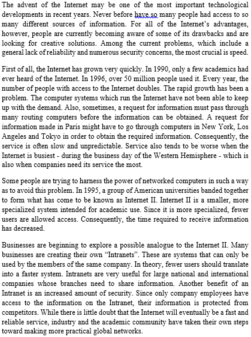Read the following passage and mark the letter A, B, C or D to indicate the correct answer to each of the questions from 36 to 42.
Although management principles have been implemented since ancient times, most management scholars trace the beginning of modern management thought back to the early 19005, beginning with the pioneering work of Frederick Taylor (1856-1915) Taylor was the first person to study work scientifically. He is most famous for introducing techniques of time and motion study, differential piece rate systems, and for systemtically specializing the work of operating employees and managers. Along with other pioneers such as Frank and Lillian Gilbreth, Taylor set the stage, labeling his philosophy and methods “scientific management’. At that time, his philosophy, which was concerned with productivity, but which was often misinterpreted as promoting worker interests at the expense of management, was in marked contrast to the prevailing industrial norms of worker exploitation.
The time and motion study concepts were popularized by Frank and Lillian Gilbreth. The Gilbreths had 12 children. By analyzing his children’s dishwashing and bed making chores, this pioneer efficiency expert, Frank Gilbreth, hit on principles whereby workers could eliminate waste motion. He was memorialized by two of his children in their 1949 book called “Cheaper by the Dozen”.
The Gilbreth methods included using stop watches to time worker movements and special
tools (cameras and special clocks) to monitor and study worker performance, and also involved identification of “therbligs” (Gilbreth spelled backwards) - basic motions used in production jobs. Many of these motions and accompanying times have been used to determine how long it should take a skilled worker to perform a given job. In this way an industrial engineer can get a handle on the approximate time it should take to produce a product or provide a service. However, use of work analysis in this way is unlikely to lead to useful results unless all five work dimensions are considered. physical, psychological, social, cultural, and power.
Question 42: All of the following are true except ______.
A. Scientific management was concerned with productivity.
B. the beginnings of modern management thought commenced in the 19th century.
C. Frank Gilbreth’s fame was enhanced by two of his children writing a book.
D. Analyzing work to increase productivity is not likely to be useful unless all of the dimensions are considered.






Đáp án B
Dịch nghĩa. Tất cả những điều sau đều đúng TRỮ.
A. Quản lí khoa học liên quan đến năng suất
B. Sự bắt đầu của nhũng suy nghĩ về quản lí hiện đại bắt đầu từ thế kỉ 19.
C. Sự nổi tiếng của Flank Gilbreth được nâng tầm bởi việc hai đứa con của ông viết sách
D. Nghiên cứu công việc để tăng năng suất sẽ ít có ích trừ phi tất cả các khía cạnh được xem xét.
Giải thích: Thông tin nằm ở đoạn 1 “management principles have been implemented since ancient times”. Thực tế có từ thời cổ đại chứ, thế kỉ 19 là sự bắt đầu của thời kì nghiên cứu quản lí đương đại.